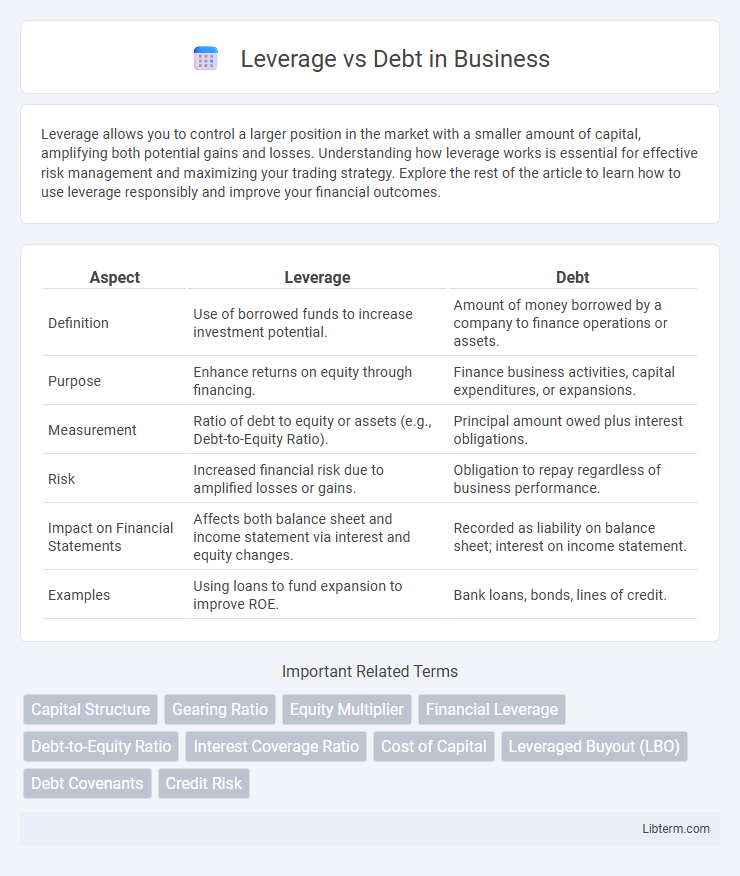Leverage allows you to control a larger position in the market with a smaller amount of capital, amplifying both potential gains and losses. Understanding how leverage works is essential for effective risk management and maximizing your trading strategy. Explore the rest of the article to learn how to use leverage responsibly and improve your financial outcomes.
Table of Comparison
| Aspect | Leverage | Debt |
|---|---|---|
| Definition | Use of borrowed funds to increase investment potential. | Amount of money borrowed by a company to finance operations or assets. |
| Purpose | Enhance returns on equity through financing. | Finance business activities, capital expenditures, or expansions. |
| Measurement | Ratio of debt to equity or assets (e.g., Debt-to-Equity Ratio). | Principal amount owed plus interest obligations. |
| Risk | Increased financial risk due to amplified losses or gains. | Obligation to repay regardless of business performance. |
| Impact on Financial Statements | Affects both balance sheet and income statement via interest and equity changes. | Recorded as liability on balance sheet; interest on income statement. |
| Examples | Using loans to fund expansion to improve ROE. | Bank loans, bonds, lines of credit. |
Understanding Leverage and Debt
Leverage refers to the use of borrowed capital to increase the potential return on investment, while debt specifically denotes the amount of money borrowed that must be repaid with interest. Understanding leverage involves analyzing the balance between the benefits of amplified returns and the risks of increased financial obligations. Companies assess leverage ratios such as debt-to-equity to determine their financial health and ability to manage debt efficiently.
Key Differences Between Leverage and Debt
Leverage refers to the use of various financial instruments or borrowed capital to increase the potential return of an investment, whereas debt specifically denotes the borrowed money that must be repaid with interest. Key differences include that leverage encompasses both debt and equity to amplify financial outcomes, while debt solely represents liabilities on a company's balance sheet. Unlike debt, leverage is a broader concept indicating the degree to which a company utilizes borrowed funds and other financial obligations to finance assets and operations.
Types of Leverage in Finance
Types of leverage in finance primarily include operating leverage, financial leverage, and combined leverage. Operating leverage measures the proportion of fixed costs in a company's cost structure, impacting earnings before interest and taxes (EBIT) sensitivity to sales changes. Financial leverage involves the use of debt to finance assets, amplifying returns but increasing risk, while combined leverage assesses the total risk from both operating and financial leverage on earnings per share (EPS).
Common Forms of Corporate Debt
Common forms of corporate debt include bonds, term loans, and revolving credit facilities, each providing varying levels of leverage to companies. Bonds offer long-term fixed interest payments, term loans come with specific repayment schedules, and revolving credit facilities allow flexible borrowing up to a set limit. Understanding these debt instruments is essential for optimizing capital structure and balancing risk with growth opportunities.
How Leverage Impacts Business Growth
Leverage amplifies a company's capacity to invest in expansion opportunities by using borrowed capital, which can accelerate business growth when returns exceed debt costs. High leverage increases financial risk and interest obligations, potentially constraining cash flow and limiting operational flexibility. Effective leverage management balances the growth potential against the risk of insolvency, optimizing capital structure for sustainable business scaling.
Risks Associated with High Leverage
High leverage amplifies financial risk by increasing debt obligations relative to equity, making companies more vulnerable to interest rate fluctuations and economic downturns. Excessive debt limits operational flexibility and heightens the probability of default, potentially leading to bankruptcy. Investors and creditors often view high leverage as a warning sign of financial instability and increased exposure to market volatility.
Advantages of Using Debt Financing
Debt financing provides businesses with the advantage of maintaining ownership control while accessing capital for expansion or operations. Interest payments on debt are tax-deductible, reducing the overall cost of borrowing and enhancing cash flow management. Furthermore, leveraging debt can improve a company's credit profile when managed responsibly, enabling easier access to future financing options.
Leverage Ratios and Financial Health
Leverage ratios, such as debt-to-equity and debt-to-assets, quantify a company's use of debt relative to its equity or total assets, serving as critical indicators of financial health. High leverage ratios suggest greater reliance on borrowed funds, increasing financial risk and potential vulnerability to economic downturns, while lower ratios indicate conservative debt management and stronger solvency. Monitoring these ratios helps investors and creditors assess a firm's capacity to meet long-term obligations and sustain operations under financial stress.
Strategic Uses of Leverage in Investments
Strategic uses of leverage in investments involve amplifying potential returns by borrowing capital to increase asset exposure beyond equity alone. Investors employ leverage to optimize portfolio performance, enhance buyout opportunities, and exploit arbitrage situations while managing risk through careful debt structuring and interest rate considerations. Effective leverage deployment requires balancing debt-to-equity ratios to maintain financial flexibility and avoid over-leverage that could lead to liquidity constraints or credit rating downgrades.
Best Practices for Managing Debt and Leverage
Effective management of debt and leverage involves maintaining a balanced debt-to-equity ratio to optimize financial performance and minimize risk exposure. Implementing thorough cash flow forecasting and stress testing helps ensure timely debt repayments and preserves liquidity under adverse conditions. Regularly reviewing leverage levels against industry benchmarks and adjusting capital structures aligned with the company's growth strategy supports sustainable financial health.
Leverage Infographic

 libterm.com
libterm.com